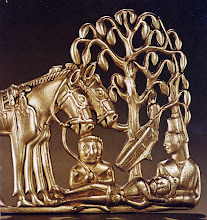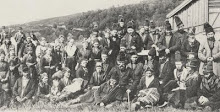Book Review
Bold, Bat-Ochir, Mongolian Nomadic Society: A Reconstruction of the 'Medieval' History of Mongolia. New York: Palgrave Publishing (St. Martin's Press), 2001. 204 pp. + xvii. ISBN: 0-312-22827-9. $59.95 cloth
Reviewed by: Timothy May, University of Wisconsin, Madison, USA, tmmay(a)students.wisc.edu
The vast majority of what Westerners have learned concerning the Mongol Empire and Mongolia between the days of the Empire and the twentieth century has been through two methods: the interpretations of Western scholars and through translations of works by Soviet scholars who rarely deviated from the theoretical and ideological methodology prescribed to them. With the fall of the Soviet Union, scholars in the former Soviet Union and its satellites, such as Mongolia, have been freed from their intellectual shackles and now must analyze their history with a fresh perspective. This is not to say that previous work under a more repressive regime did not have merit, but nevertheless, variance from the official interpretation of Marxism was marginal. While many Western scholars disagreed with Marxist interpretations of history, the Marxist influence concerning pastoral-nomadic society, though often criticized, continues to have a great impact on the interpretation of Mongolian history. This fact alone makes Bat Ochir Bold's book, Mongolian Nomadic Society: A Reconstruction of the 'Medieval' History of Mongolia, an important development in the historiography of all aspects of Mongolian history.
Bat-Ochir Bold, a Mongolian scholar at the University of Iceland, has set forth to examine the current views on Mongolian nomadic society, namely that it was a feudal structure. He views his book as an attempt to study the structural and developmental characteristics of Mongolian nomadic society over the course of Mongolian history. Approaching this topic from theoretical and empirical perspectives, Bold focuses his work from the twelfth century to the twentieth century due to the source material available. After the twelfth century a fairly stable and independent Mongolian society existed. In his opinion, although political institutions changed, nomadic society remained relatively unchanged until the 18th century, when the combination of Manchurian rule and the growth of Buddhism hampered the development of Mongolia and altered nomadic society.
Mongolian Nomadic Society is divided into six chapters and a conclusion. The first chapter focuses on the source material. Bold evaluates the primary and secondary materials through historiographical and cultural interpretations. The core of the study, chapters two through four, examines the structural elements of nomadic society. These include the roles of social and economic factors as well as tribal and political-administrative elements. In these chapters, Bold compares pre-industrial Europe with feudalism in Mongolia, essentially comparing Europe with a Mongolian model of production. Although this, on the surface, seems absurd, is it not the reverse of what Marxist and non-Marxist scholars have done? The fifth chapter focuses on the spread of Tibetan Buddhism in Mongolia and its ramifications on nomadic society. The sixth chapter attempts to depict the essence, function and evolution of traditional nomadic society. Then, in his concluding remarks, Bat-Ochir Bold outlines the internal structure and evolution of traditional nomadic society.
In Bold's view, attempts to evaluate Mongolian history have been mired in two problems. Attempts prior to 1921, when Mongolia entered the sphere of Soviet influence, were bound to tradition, which included Buddhist and Chinese interpretations of events. After 1921, a new generation of scholars made their own attempts to reinterpret their history, but suddenly found themselves, both willingly and unwillingly, examining their past through the lens of Marxist dogma, often dictated from the Soviet Union.
According to Marxist-Leninist theory, society moved through five stages: primitive society, slavery, feudalism, capitalism, and finally socialism, with communism being the pinnacle of socialism. For Mongolia, and their Soviet allies, this presented a problem. If these stages were applied to Mongolia, it was quite apparent that Mongolia never reached a capitalist stage. Therefore, they were in a feudal stage before the intervention of the Soviets and the Mongolian People's Revolutionary Party (MPRP). To accommodate this and similar problems in Central Asia, the Communist party adopted the idea that certain stages could be bypassed en route to socialism. During this period, the Soviet scholar Vladimirtsov coined the idea of nomadic feudalism in 1934. Although many scholars discussed this concept, most adhered to it. Even as late as 1976, it remained an essential part of Mongolian historiography, although many scholars, Western as well as Soviet, rejected it based on its theoretical ambiguity. Nevertheless, nomadic feudalism remains a model that scholars examine and use today.
To dispute the concept of nomadic feudalism, Bold delves into the structure of nomadism. In doing so, he asks two questions: to what extent has ecological change influenced animal husbandry in Mongolia; and, how has the origin of livestock keeping been determined ecologically? Although the questions are similar, they intertwined and have not received much attention. After examining this, he then compares the results for the Mongolian nomadic economy with that of feudal Europe.
In the third chapter, Bold examines the evolution of the Mongolian socio-political organization, ranging from the tribe to the various forms of kinship, both fictive and non-fictive. By doing so, we see the development of the state, prompting Bold to ask: should this state be considered feudal? And if so, how should feudal be defined?
During his examination of the social strata, Bold relies heavily on the research of Mongolian, Soviet and Hungarian scholars. An integral part of chapter four focuses on the terminology used in discussing the social structure before and after the Manchurian period, and how both periods differentiate between Chinggisids and non-Chinggisid taiji, or nobles.
Many readers will find chapter five especially interesting. The debate on the effects of Buddhism on Mongolia has always been a heated one. Arguments range from Buddhism essentially ruining the martial ardor of the Mongols and depleting it of manpower to the other end of the spectrum that it benefited the Mongols by introducing a world religion and ending the influence of shamanism. Bold, to his credit, does not fall into the trap of entering this debate. Instead he turns his attention to how Buddhism or rather Lamaism affected the nomadic economy. One aspect that he covers, which is often overlooked, is that permanent monasteries did not spring up overnight. Instead, they gradually evolved from a ger and eventually became the large fixed structures that are commonly associated with Lamaism.
In the final chapter, Bold examines the dynamics of the development of Mongolian nomadic society, particularly in the areas of livestock, family, political structure, and military conflict. Through the study of these elements, Bold then examines why the nomads of Central Eurasia were so aggressive and why they were so successful. As part of this study, Bat-Ochir Bold includes climatic problems, the mobile lifestyle of the nomads, their strategies, and, surprisingly, the role of shamanism with its focus on the Möngke Köke Tengri, or Eternal Blue Heaven. The religious element of the nomadic conquests is something that is all too commonly overlooked and has attracted little research. In his discussion of the evolution of nomadic society, he concludes, quite plausibly, that it is erroneous to conclude that a single dramatic change occurred, such as with the introduction of Buddhism, or the Mongols' incorporation into the Manchu Empire, but rather change was gradual and not immediate.
Bold concludes that Mongolian nomadic society is so different from Medieval or Northern Europe that one cannot study Mongolia based on models draw from those used to study Europe, and for that matter, China. The evolution of agricultural and nomadic peoples are simply too disparate to establish a model from one and apply it to another.
Mongolian Nomadic Society is a welcome addition to the study of Mongolia as well as the study of state formation. Too often scholars, often unconsciously, apply methods based on one culture or society that are woefully inadequate and inappropriate for another. The cultural context must always be kept in mind. There are a few minor issues with his system of transliteration, such as his use of "Genghis Khaan." In his note on transliteration, he maintains that he prefers to use this as it is more familiar to Western readers, but the use of Khaan is not familiar at all. Although it is a perfect transliteration from the modern Mongolian, it is odd to the Western eye. Nevertheless, these are minor issues and do not detract from the questions he poses. The importance of this volume is not so much his overall conclusions, but that it may serve as a stimulus for scholars to rethink how they view Mongolian nomadic society, even if they disagree with the author.




